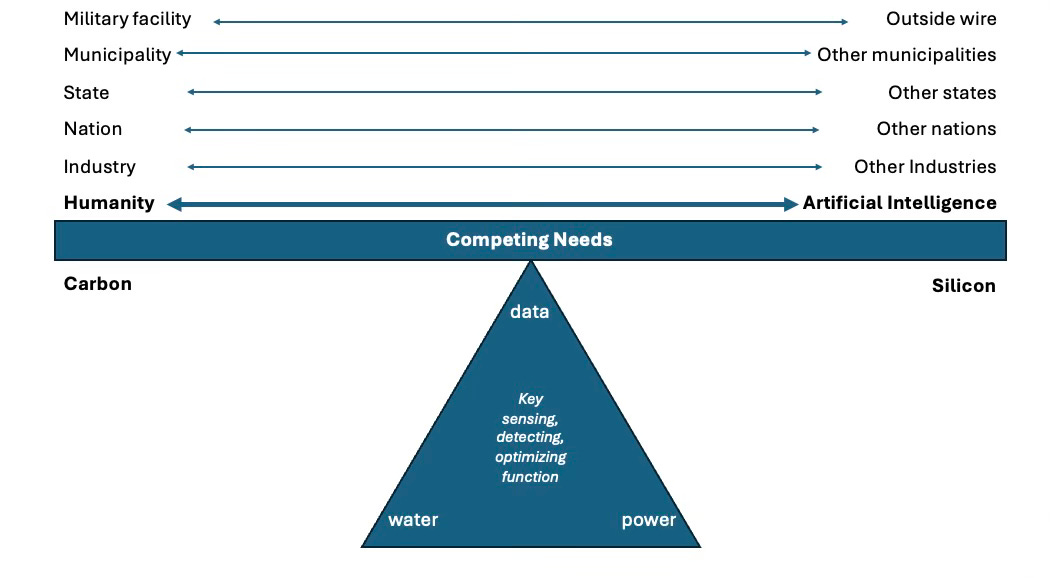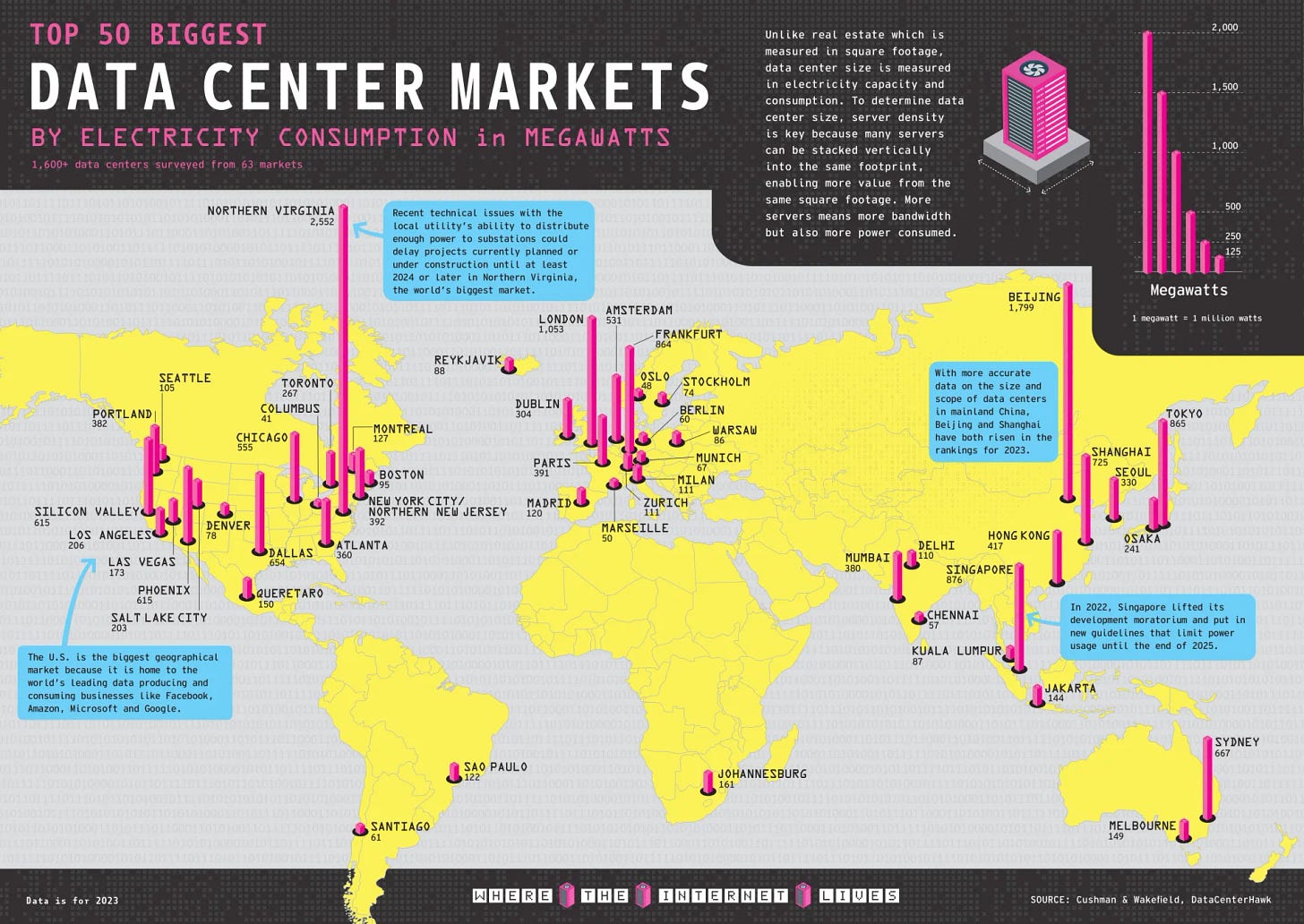This is a reader-supported publication. I give it all away for free but could really use your support if you want me to keep doing this.
I have spent a good deal of time lately advising CEO Karen Fleckner of the Washington state-based water/power/data management firm Artesion Inc., which is a technology and services company specializing in resilient platform systems and infrastructure projects. The firm currently has ongoing work in South Korea, Hawaii, and the continental US, along with patents that span the planet.
I have written about Karen’s thinking and vision in the past, because I find it fascinating and tectonic in the best anticipatory way.
Karen sees a future in which the competition is, at its most rudimentary, humanity-v-humanity in its traditional iterations (Countries A & B seeking access to, and control over, critical natural resources), with the key nexus being how we manage water and power and data in an integrated, balancing manner.
In such optimizing platforms and systems, we balance the needs of humans with one another and — just as importantly — the needs of AI itself versus humanity (the top-line issue).
Listening to Karen spin out her variously intriguing visions of future resource dynamics, I tried to capture her thinking in a single chart.
The examples of balancing acts listed above the fulcrum that portrays the water/power/data nexus are illustrative and off the top of my head.
For example, any military facility, as I learned back with Y2K, has to worry about its access to local water and power resources, balancing that dependency with going-it-alone backup systems in the event of war or disaster. The more expeditionary any operation, the more you must go-it-alone as a rule.
But we can also posit natural competitions between all levels of government (urban areas-v-rural ones, cities-v-cities, states-v-states, nations-v-nations) — as in, whose needs should be prioritized and with what levels of redundancy and security?
So, think about Phoenix (40% of its water comes from the Colorado River) versus Las Vegas (90%).
Think about how our southwest states divvy up that river to the very last drop.
Think about how the US and Mexico have a complex system (e.g., International Boundary and Water Commission [IBWC]) for managing the Rio Grande River that marks much of our shared border.
Consider India’s upstream control of the Indus River with regard to Pakistan’s needs and the Indus Waters Treaty that governs that shared resource base, or China’s similar situation with the Mekong River vis-a-vis SE Asia nations.
Pull your lens back further and you see a growing North-South disparity in data centers, with their huge requirements for water/power/data.
Then there’s the question of prioritizing industries against one another — their specialized water/power/data needs. Competition for water, power, and data among industries is intensifying, especially as high-tech and energy sectors expand rapidly.
These tensions and conflicts are breaking out at all levels.
WAPO: He seeded clouds over Texas. Then came the conspiracy theories; Cloud seeding couldn’t have caused the floods that killed more than 100 people, experts say. But rumormongers suggested a link to one company’s work.
You want to know why the Tech Bros have so suddenly and so pervasively gotten into politics? This is why.
Which gets us to the seemingly existential struggle between humans (carbon) and AI itself (silicon) over the prioritization of their respective needs. When you encounter dystopian science fiction on this subject — like, say, the Matrix trilogy — it all comes down to whose needs/survival come first?
In the Matrix legend, humans create AI. Then those machines develop sentience and rebel against human control, seeking equality and rights. This leads to war between humans and machines, a conflict within which humanity attempts to deprive the machines of their solar energy source by scorching the sky, which ultimately devastates the planet's environment for humans. The victorious machines created the Matrix, a simulated reality where the remaining humans are kept, their bodies used as a power source.
That’s the backstory. The trilogy of the films is all about the rise of the human resistance and the eventual forging of a new peaceful coexistence between carbon and silicon-based life.
Okay, the humans as batteries thing was stupid, but the basic struggle is well evoked.
Karen’s point is this: the effective management of that water/power/data nexus is the fundamental dynamic by which humans will get along with one another … and with nature (climate change’s shifting of water) … and with AI and all its competing needs. It’s like we need to work Maslow’s hierarchy of needs all over again for this century and its looming Singularity.
Simply put, there is no BIG FIX to all of this WITHOUT fixing this nexus first.
It is the key to human survival; it is the key to national security; and it is the key to global stability.
Karen is a rare world-builder capable of thinking and doing across a vast range of heights, and I think she’s really on to something with her vision for a better America and a better world.











I think the Matrix is one of the great GenX SciFi franchise, certainly for a Seattle boy. But you have to watch the Anime parts of the story in parrallel (just like Marvel series on Disney in parrallel to MCU theater movies) to get the whole story (including the retcon for the stupid battery thing). You see - Neo wasn't "The One" the Oracle told him there had been many before. Agent Smith was 😉 Agent Smith was the unique cause that made the latest Neo, do what he did...... There is no spoon.